Field Notes: “Mom, Look! It’s George, and He’s a TV Indian!”
The title for this article came from my daughter, Elizabeth.
The title for this article came from my daughter, Elizabeth. One day last year when I picked her up from kindergarten, she came rushing to me with a scrunched-up, angry face. Before she even said hello, she plopped down on the hallway floor and opened the George and Martha book she’d checked out of the school library and read earlier that day. Sure enough, there he was. One of her favorite characters, wearing feathers, dressed as an “Indian.”
“See?!” she said to me, in the indignant voice of a five-year-old, as she jabbed at the illustration and then slammed the book shut. Later that year, we snuggled beneath a blanket, opened another library book (Martha the Movie House Mouse), and began reading. Partway through the book, there they were again. TV Indians. This time, though, Elizabeth just rolled her eyes and muttered “TV Indians,” and we kept on reading.
So, what’s the big deal? What are “TV Indians”? Understanding our use of that phrase requires that you know who Elizabeth and I are, and why these illustrations get our attention. We are Pueblo Indians, from Nambé, a small Indian village in the northern part of New Mexico. I grew up on the reservation, took part in traditional dances, and attended public school with my cousins, with Pueblo children from four other Pueblos, and with Hispanic and white children. Because of where we lived and with whom we interacted, all concerned held fairly accurate images in their minds about Native American people.
Now, however, I am a doctoral student at the University of Illinois, in an area of the state with a very low Native population, and things are very different for my young daughter. Soon after moving to this area, we realized that children and adults have inaccurate or romantic ideas about who Native American people are. For the most part, children of Elizabeth’s age see stereotypes of Native Americans that lead them to believe either that Indians don’t exist anymore, or that Indians are very exotic people who wear feathers and live in ways vastly different from their own.
We can’t really blame the children for these ideas. They see stereotypes in series books their well-meaning parents buy at grocery and department stores. For example, in Clifford’s Halloween, Clifford is shown wearing a full headdress; in Berenstain Bears Go to Camp, Grizzly Box wears a headdress and buckskin as he tells a story to the scouts gathered around a campfire. In the popular children’s television program Muppet Babies, there is an episode in which the character called Animal dons feathers, rides a pony, and says “How!” And another character explains that “’How’ is the Indian way of saying hello.” Many books children find in school libraries or on classroom shelves often contain similar illustrations. For example, Maurice Sendak’s Alligators All Around has alligators dressed in headdresses on the “I” page, and Bill Martin Jr’s Knots on a Counting Rope shows Native people wearing traditional clothing at a horse race, as though these ceremonial clothes are everyday attire. In Susan Jeffers’s controversial book about Chief Seattle, Brother Eagle, Sister Sky, the illustrations present Seattle dressed in a large feathered headdress and wearing fringed buckskin as though he were from a Plains Indian tribe, rather than from the Suquamish, a tribe on the West Coast. Finally, the University of Illinois mascot is an Indian chief who looks a lot like Jeffers’s depiction of Seattle in his own large headdress and fringed buckskin.
Given this ubiquitous set of visual representations of exotically feathered and fringed Native Americans, it is easy to understand the comments children make. On a visit to a local preschool, a four-year-old asked me why my skin is brown. I told her that I was a Native American Indian person. With a puzzled expression, she cocked her head and said, “But Indians aren’t real! They’re all dead.” On a visit to a first-grade classroom, a child approached me and asked, “How did you get here?” He paused, and then asked, “Do you have a car?” I smiled and said, “Yes! A red one.” To which he said, “But Indians don’t have cars! They have horses.”
As adults, we know that Native Americans have not, indeed, vanished, and we know there are differences in language and culture from one Native American tribe to the next. Some of us even know there are currently over five hundred different Native American tribes. Our children, however, don’t know what we know. We can help them by reading books to them that provide information about contemporary Native Americans, and that accurately portray the diversity among Native American people. With some effort, we can locate such books, but it does require a bit of work.
Most of the good books about Native Americans are folktales. Some are retold by Native American authors (Michael Lacapa’s Antelope Woman; Gayle Ross’s How Turtle’s Back Was Cracked) while many others are retold by non-Natives (Paul Goble’s The Girl Who Loved Wild Horses; Nancy Van Laan’s Shingebiss). As a Native person, I am glad there are many from which to choose, but while the folktales are beautiful, they are usually set in the past and may, perhaps, reinforce the idea that Native American people don’t exist anymore. In a few cases, picture book authors are presenting folktales in the ways they are told to contemporary Native children. For example, in Virginia A. Stroud’s Doesn’t Fall Off His Horse and Bruchac and Ross’s Story of the Milky Way, the opening and closing pages provide the reader with illustrations of contemporary Native elders telling stories to contemporary Native children in modern homes.
There are also several excellent nonfiction photo essays available (see, for example, the We Are Still Here series published by Lerner). But, unfortunately, there are very few picture books that simply tell stories about contemporary Native children. Here are some that do, suitable for story hours with young children. (A more complete list of books — “Native Americans: Recommended Books and Resources” — is available at no charge by calling the ERIC Clearinghouse on Elementary and Early Childhood Education at 1-800-583-4135.)
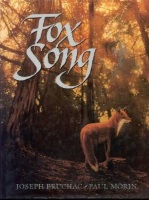 Joseph Bruchac Fox Song; illus. by Paul Morin
Joseph Bruchac Fox Song; illus. by Paul Morin
32 pp. Philomel 1993 ISBN 0-399-22346-0 14.95
Jamie, a six-year-old Abenaki/French girl, is reluctant to get out of bed and begin the day without her Abenaki grandmother, who has just died. With her eyes shut tight against the morning sun, Jamie thinks about the many wonderful days she spent with her Grama Bowman, picking berries, making baskets, learning about her Abenaki heritage. Morin’s warm illustrations of Grama and Jamie in jeans and tennis shoes establish the contemporary time period. As Jamie reflects on their time together, she gathers the courage to get up and go for a walk, where she realizes that her Grama’s presence is all around her.
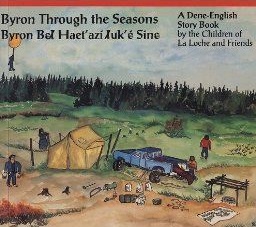 The Children of La Loche and Friends Byron through the Seasons: A Dene-English Story Book
The Children of La Loche and Friends Byron through the Seasons: A Dene-English Story Book
40 pp. Fifth House 1990 Paper edition ISBN 1-895618-33-9 10.00
Byron’s grandfather, Jonas, visits Byron’s classroom to tell the children a story about the seasons in their home of La Loche, Saskatchewan. The first page of the story shows Jonas, seated on a swivel chair in the classroom, with the children sprawled about the carpeted classroom floor, ready to listen to his story. The next pages show what Byron sees in his mind as his grandfather talks. The illustrations, done by Dene children, are a delightful mix of the contemporary and the traditional: alongside the four-wheel drive truck is a snowmobile as well as a dogsled team. The text is printed in English and Chipewyan. The final pages include a black-and-white photo of the children who worked on the book, and supplementary information on the Dene people.
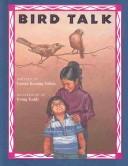 Lenore Keeshig-Tobias Bird Talk; illus. by Polly Keeshig-Tobias
Lenore Keeshig-Tobias Bird Talk; illus. by Polly Keeshig-Tobias
28 pp. Sister Vision: Black Women and Women of Color Press 1991
Paper edition ISBN 0-13-727264-2 7.00
In this book, the text is printed in English and Ojibway. Polly and her family have moved away from the reserve (as it is called in Canada) to a city where Polly’s mother can go to college. Polly’s mother calls her daughters her little brown birds, hence the title. Polly has had a bad day at school, but doesn’t want to talk about it; eventually, she tells her Mom that it was because the kids wanted to play cowboys and Indians. In the rest of the story, Polly’s mother comforts her by talking about their grandparents and relatives back on the reserve. And then she promises Polly that she will visit her classroom to tell the children about Native Americans.
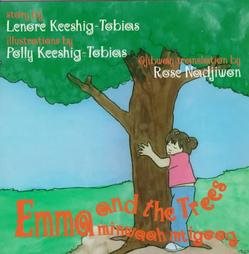 Lenore Keeshig-Tobias Emma and the Trees; illus. by Polly Keeshig-Tobias; Ojibway translation by Rose Nadjiwon
Lenore Keeshig-Tobias Emma and the Trees; illus. by Polly Keeshig-Tobias; Ojibway translation by Rose Nadjiwon
24 pp. Sister Vision: Black Women and Women of Color Press 1996
Paper edition ISBN 0-920813-11-9 10.00
Emma and the Trees is simply a story about a little girl who doesn’t want to go to the store with her Mom. She fights with her Mom every step of the way, from putting on her jacket to climbing into her sled. Emma’s Mom knows that she loves trees, so to distract her, she calls Emma’s attention to the trees, which are waving in the breeze. She tells Emma the trees are saying, “Don’t cry,” as they wave at her. It works! Again, the text is in English and Ojibway.
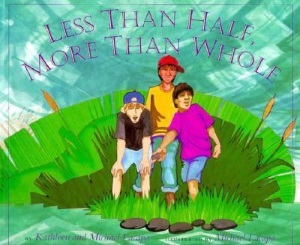 Kathleen and Michael Lacapa Less than Half, More than Whole; illus. by Michael Lacapa
Kathleen and Michael Lacapa Less than Half, More than Whole; illus. by Michael Lacapa
40 pp. Northland 1994 ISBN 0-87358-592-5 14.95
As a group of children are playing together, they notice their skin tones are not alike. Tony, the biracial child, is told he is half Indian, or maybe less than half. Pondering this, Tony talks with his grandfather, who shows him a bundle of corn. Some of the ears are a single color, some are multicolored. His grandfather tells him the Creator made corn in many colors, and that this makes the world more beautiful. When he looks at the multicolored ear, he sees great beauty, and tells Tony that he is like that ear of corn: many colors that are one whole person.
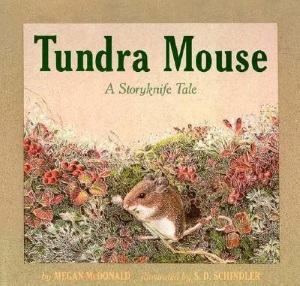 Megan McDonald Tundra Mouse: A Storyknife Tale; illus. by S. D. Schindler
Megan McDonald Tundra Mouse: A Storyknife Tale; illus. by S. D. Schindler
32 pp. Orchard 1997 ISBN 0-531-30047-1 15.95
Library edition ISBN 0-531-33047-8 16.99
In an unusual format, this book opens with Elena using the Yup’ik traditional storyknife technique (drawing pictures in mud or snow with a knife) to tell her sister, Lissie, the story of the tundra mouse who got into their home the winter before. The fact that this is a contemporary story is made clear by the illustrations, such as the one of Elena’s grandmother riding her snowmobile.
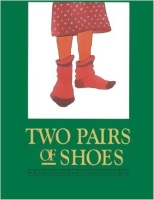 Esther Sanderson Two Pairs of Shoes; illus. by David Beyer
Esther Sanderson Two Pairs of Shoes; illus. by David Beyer
24 pp. Pemmican Publications 1990 Paper edition ISBN 0-921827-15-6 11.00
Maggie is a young Ojibway girl. On her birthday, her mother presents her with a gift. Maggie hopes it is what she wanted: a pair of black patent leather shoes! Of course, it is. She puts them on and races off to show them to her grandma. Her grandma praises them (as good grandmas do), and then gives Maggie another present. This time, it is a pair of beaded moccasins. Sanderson does a fine job weaving together the contemporary with the traditional, and the grandmother’s presence in the story reflects the importance of extended families and elders within Native American communities.
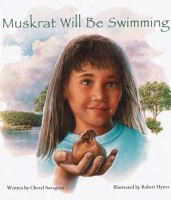 Cheryl Savageau Muskrat Will Be Swimming; illus. by Robert Hynes
Cheryl Savageau Muskrat Will Be Swimming; illus. by Robert Hynes
32 pp. Northland 1996 ISBN 0-87358-604-2 14.95
This story is about Jeannie, a little girl from a poor Native American family. Although her house is not as nice as those in town, and though she wears hand-me-downs, she is happy that she lives near a lake where she spends hours watching the insects and animals. In school, some of her classmates tease her, calling her a Lake Rat. One day after school, she sits forlornly on the steps of her house, where her grandfather finds her. Together they visit the lake and talk about the names people call each other. They decide a Lake Rat must be a muskrat, and her grandfather tells her a creation story about the muskrat. Her grandfather’s words and the creation story help her overcome her feelings of sadness over the label “Lake Rat.” She says, “So I don’t worry anymore when kids call me a Lake Rat. I know who I am, and I know about the lake, that we’re part of it, and it’s part of us.” The illustrations of the houses in town, the climbing structures in the school yard, and the clothing the children wear clearly place this story in a contemporary setting.
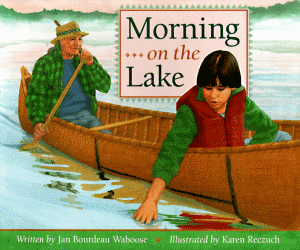 Jan Bourdeau Waboose Morning on the Lake; illus. by Karen Reczuch
Jan Bourdeau Waboose Morning on the Lake; illus. by Karen Reczuch
32 pp. Kids Can Press 1998 ISBN 1-55074-373-2 15.95
Noshen (Ojibway for grandson) and Mishomis (Ojibway for grandfather) spend a day together; at dawn they encounter a loon, at noon an eagle, at night a wolf. Reczuch’s watercolors capture the intimate relationship of the boy and his grandfather, and the quiet beauty and grace of the outdoors. Exquisite renderings of traditional Ojibway beadwork are sprinkled throughout this story, which effectively conveys the role of elders in the transmission of culture and values in contemporary Native American families.
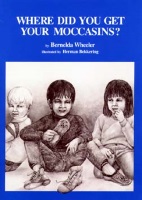 Bernelda Wheeler Where Did You Get Your Moccasins?; illus. by Herman Bekkering
Bernelda Wheeler Where Did You Get Your Moccasins?; illus. by Herman Bekkering
24 pp. Peguis Publications 1992 Paper edition ISBN 1-895411-50-5 6.00
Paper edition ISBN 1-895411-50-5 6.00”
Bekkering’s illustrations clearly place this story in a modern-day classroom. There are modern buildings, children in jeans and T-shirts, and low shelves in the classroom filled with books and writing materials. The story is about a Native child who has brought his moccasins to school for show-and-tell. In a question-and-answer pattern, his classmates ask him questions about the moccasins. For example, they say, “Hi, Jody. Where did you get your moccasins?” And he replies, “My Kookum made my moccasins for me.” “Who is your Kookum?” “My Kookum is my Grandmother. She made my moccasins for me.” The pattern continues; each time Jody provides a little bit more information that reflects the traditional aspects of his Native culture. In the last sequence, the children ask where his grandmother got the beads she used to decorate his moccasins. He replies, “From the store.” Wheeler’s story depicts Jody as a contemporary Native child whose family takes part in traditional activities.
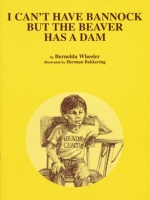 Bernelda Wheeler I Can’t Have Bannock, but the Beaver Has a Dam; illus. by Herman Bekkering
Bernelda Wheeler I Can’t Have Bannock, but the Beaver Has a Dam; illus. by Herman Bekkering
32 pp. Peguis Publications 1993 Paper edition ISBN 1-895411-48-3 6.00
This story opens with a child saying to his mother, “Mom, can I have some bannock?” (Bannock is a traditional bread made by the Native American people in northern Canada.) But a beaver has gnawed down a tree to build his dam, knocking out the family’s electricity. The boy has to wait till the wires are repaired before his mother can make bannock. Wheeler’s story incorporates traditional foods in a modern-day setting (and a recipe for bannock is included).
Debbie Reese is author of the blog American Indians in Children's Literature (AICL).
From the September/October 1998 issue of The Horn Book Magazine.
RELATED
ALREADY A SUBSCRIBER? LOG IN
We are currently offering this content for free. Sign up now to activate your personal profile, where you can save articles for future viewing.







Add Comment :-
Be the first reader to comment.
Comment Policy:
Comment should not be empty !!!